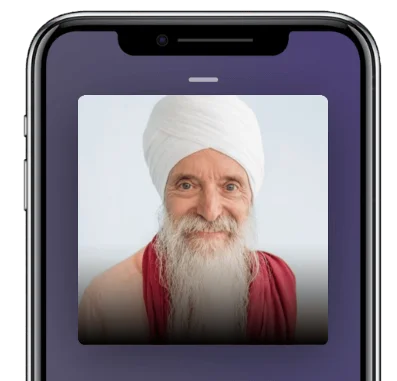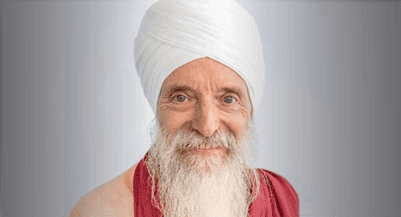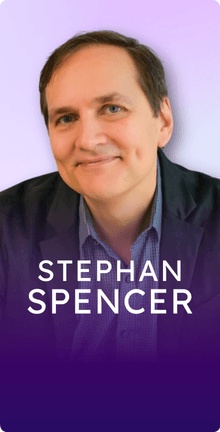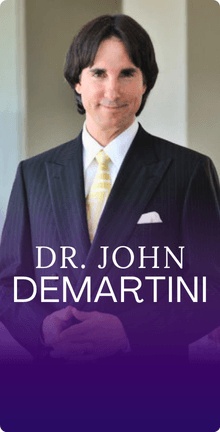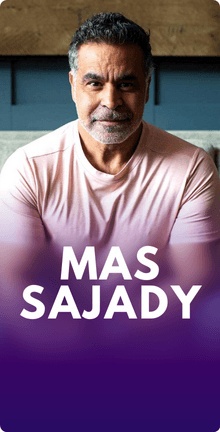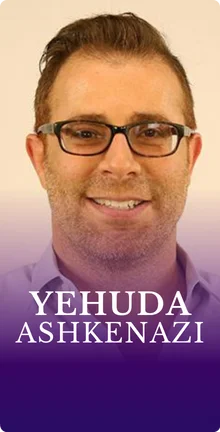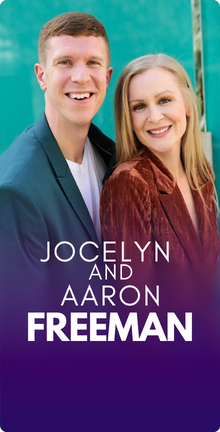In this Episode
- [00:40]Stephan introduces Guru Singh, a vibrant third-generation yogi, master spiritual teacher, author, and musician.
- [06:11]Guru explains the positive effects of not getting too caught up with other people’s opinions.
- [13:01]Guru points out that the more you understand about a person’s life and what they’ve gone through, the deeper your compassion is for them.
- [19:20]What is the true nature of a human being? Guru shares his childhood experiences and the time he discovered his purpose in life.
- [24:52]Stephan tells a story of how a painful moment in his life led him to finding peace and profound growth.
- [31:16]Guru discusses the different types of yoga and how it affects a person’s overall health.
- [36:51]What’s the difference between Kundalini Yoga and Hot yoga?
- [42:03]Guru shares his daily routine of yoga, chanting, and meditation to get his body and psycho-emotional system in shape.
- [50:40]Stephan and Guru talk about Paramahansa Yogananda’s book, Autobiography of a Yogi.
- [55:32]Visit Guru Singh’s website, gurusingh.com, to find out Kundalini University’s schedules of classes, meditation, yoga, courses, and more.
Guru Singh, it’s so great to have you on the show.
Great to be back with you, even if it is at a distance, right?
That’s right. Interesting times we live in for sure. So I recall, when we first met, it was a decade ago, and we were on a trip together with Tony Robbins and a whole bunch of Platinum partners. We went to Jerusalem, and then to Egypt. What a fantastic trip, just remarkable. An inspiring trip that was. That was my first time in Israel, which is where I’m recording right now. I’m in Tel Aviv now, but Jerusalem was where we first met. I would love for you to share with our listeners how you ended up being part of Tony Robbins’ inner circle and being invited on these amazing, life-changing trips to help inspire and change the lives of the folks who are in attendance.
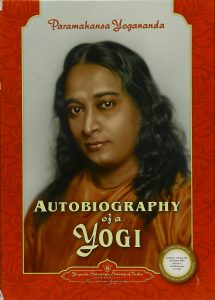
Tony and I have known each other personally since 1993. We met around a spiritual gathering at that time. Since the very beginning, he and I recognized the tremendous similarity between our paths and our aspirations, and therefore we kept in touch. We then got drawn back together around the whole concept of Oneness and that celebration of the spiritual energy that we as human beings have the capacity to not only possess but the capacity to share with each other. We can share it through our prayers; we can share it through our meditations, we can share it through our activities. I’ve been studying yoga basically since birth because I was raised by a mother and a father who were a musician and an artist, and were both yogis and followers of Swami Sri Yukteswar, who was Paramahansa Yogananda‘s guru. Paramahansa Yogananda, obviously, the author of Autobiography of a Yogi.
We got drawn back together around our mutual friendship and working relationship with His Holiness the Dalai Lama in San Francisco in 2007, which was 14 years after we had first met. We looked at each other, and we said, “We have to do some things together.” And so that’s how it all got started. He started me working with the Platinum partners, which were a much smaller group back in those days. Currently, it’s a couple of 300. But it was a cozy group. And the first time we went out, we went to Fiji and Bora Bora, and then we went to Sun Valley, and then we ended up with you in Jerusalem and also back in Cairo. For the listeners and viewers, Stephan and I recall our time at the airport, traveling from Tel Aviv to Cairo. And the delays upon delays upon delays of the charter plane that we were to get on and travel. So we just brought out our yoga mats, and we did our yoga, and I brought out my guitar, and we had a festive time right there on the floor of the boarding area in the Tel Aviv airport. I’m sure that the airport has never had quite a similar event in its history.
Yeah, so you were singing songs, and the whole group was singing with you, and you’re playing the guitar. It was magical.
Those are magical things when people can gather together and have the freedom of inhibition, to be able to let loose and to sing and to just feel free to be themselves at any moment. And that’s kind of how you and I met, around that kind of human energy.
It’s magical when people can gather together and have the freedom of inhibition, to be able to let loose and to sing, and to feel free to be themselves at any moment.
Yeah. So people are so caught up with how they look, looking good, not looking bad, and you stifle yourself and your creativity and your ability to reveal light when you’re so concerned about what other people think of you; I recall hearing that, I forget from who, but what other people think of you is none of your business. That’s profound.
That’s a good one. I always heard that we are a slave to “OPO,” other people’s opinions. To set yourself free from that is not to disregard other people’s opinions, but in a deep sense of respect, you take on your own opinion first, and then you let other people’s opinions model it, mold it and help it. I love that what other people think of you is none of your business.
That’s such a projection. There’s no real basis in reality. They’re watching their own movie, they’re in their own theater watching the movie that they think is the real world, and you’re just a projection to them that they’re trying to fill in the missing information. They don’t know the depth of amazingness that each of us is.
Yes, Stephan, this is the basis of most spiritual teachings is to unmap and disconnect all of those inner relationships that we yogis call “Maya,” the production of Maya, the illusion. Unmapping, remapping, and reformatting all of those inner relationships between your physical body, your emotional body, and your mental body so that you can begin to see things not as you believe they are, or as you think they are, but you can begin to perceive things as they are. And that’s the purpose of everything that I teach, that’s the purpose of your podcast, is to bring people in touch with that true sense of the way things are and to set them free.
I often hear the phrase, 'We are a slave to other people's opinions.' To set yourself free from that is not to disregard theirs. But, in a deep sense of respect, you take on your own first. Then you let other people's opinions model,… Share on XYeah. The way I like to think of it is as I want to help people not just with their awareness, but with their awareness of their awareness.
I love that; that’s very similar to what a great educational professor once said, “We don’t learn, we learn how to learn.” And because the information is already with us, we just have to open to that information, which is why it’s called, “Remember, recall and recognize,” is that you’re just becoming aware of what’s already there. And it’s just like you and I, for us to connect in this virtual way. Our devices had to access that universal internet, right? The global internet. So the global internet is always there, and you’re always where you are; I’m always where I am. When we allow ourselves to connect through that mechanism, then all of a sudden, we see each other; everyone on this podcast sees us, experiences this, and this is literally what we are in this world. That we are opening up, we are learning to learn, we are allowing ourselves to be open to that which is always there and is not only always there, but it’s always there within us as well. So here we can make connections in that way. It’s beautiful. It’s called awakening, isn’t it?
Yes. One thing I’ve learned from, well, there are many spiritual disciplines that I like to learn from, and two of the big ones have been Oneness and Kabbalah. Specifically from Kabbalah, one thing that comes to mind when we’re talking is this idea of the 99% reality. So we live in what’s known as the Malchut, the physical reality, where you got to pay your bills, and you hop on an airplane to fly somewhere. And that’s very physical, very kind of real, this desk right here is solid, but it’s not actually. There’s more space in that desk than there is solid material in terms of the atoms and space between the subatomic particles and so forth. So recognizing and just being cognizant that there’s this 99% of the reality that we are not experiencing because it’s in higher realms, higher dimensions. But knowing it’s out there helps you to live more intentionally and be just more open, like not just getting stuck in the day to day, but realizing there’s a much, much bigger picture. And we’re just experiencing 1% of what is out there; if that, it’s probably a fraction of 1%. So that’s a pretty cool way of looking at things.
People open up to excellent knowledge by exploring the unknown; thus, people shut down the unknown because they fear it’s inappropriate.
Exactly. And think of it not so much as being out of the idea of a dog whistle; is that when you blow it, dogs hear it, but you don’t. So it’s not out there anywhere; it’s right here. These dimensions are not beyond space; these dimensions are right here in front of us, this dog whistle is right there at your ear, but your ear is not able to perceive it. And so in your metaphor of the 99% that we are unaware of, what we teach, and when you’ve broadcast to promote in many different ways can you enable yourself to become more aware, more awakened to this aspect that is in the 99%. We’ll never get the whole 99%, but any amount of it that we gain access to, that we become open to, gives us a greater understanding of everything 1% because everything in the 1% has a relationship with a 99%. And the more you get in touch with the relationship or something, the more you understand about a person’s life, how they what they’ve gone through in their life, the deeper your compassion is for them at this moment.
I find that to be especially important at this particular time when there’s so much diversity. In this expanded and accelerated diversity, what ends up happening is even people that are open and very compassionate, because they stand for those who are extremely brutal and extremely malevolent. And these are what the great masters said; these are the tripwires in that conscious path. Because even those people are a product of a series of events, and if we access a small portion of what you call the 99%, what the Kabbalah calls the 99%, you gain access and insight to those parts of very ornery terrorism that lets you see, “Ah, I understand now how they became so malevolent.” “I understand how they became who they are.” Not that you’re going to condone their behavior but you will be more effective in placing it or even perhaps in correcting it by understanding where it comes from. And that’s a successful path.
Yeah, and to even see how their role as a malevolent force or the malevolence that they are exuding because of their being lost or wounded is serving the greater good in some bigger picture that we can’t see.
This is what we are doing in this world — we are opening up, learning to learn, and allowing ourselves to be open to that which is always there within us.Guru Singh
Correct. It’s interesting, by the way, and to expand upon what you just said, in what was called the “Dark Ages,” the Medieval Times, right around the areas that we’re in right now, there were two factions. One was the Arabic movement, and the other was the Judeo Christian, and it was around the time of Pope Gregory. What the authorities at that time determined was that the shadows in art and the harmonic intervals that were not in unison were dwelling places for the dark forces. And so that’s where Gregorian chanting came in, and very two-dimensional art. And at the same time, the Arab world was inventing algebra, which is an Arabic term. They were learning about human anatomy, which the generic world said was inappropriate for us to dissect a cadaver. So these kinds of motions take place throughout history.
Where people open up to great knowledge by exploring the unknown, and where people shut down the unknown because they fear that it’s inappropriate. What you were just saying is similar to that; we explore all of these things. Like you say, the malevolent force, in a larger picture, is just like the shadow in a drawing; if all you’re into is just that shadow, then it looks dismal. But if you take a step back, you see that the shadow in an art portrayal gives you perspective. Just as that malevolent person then ultimately gives you perspective, in a larger picture.
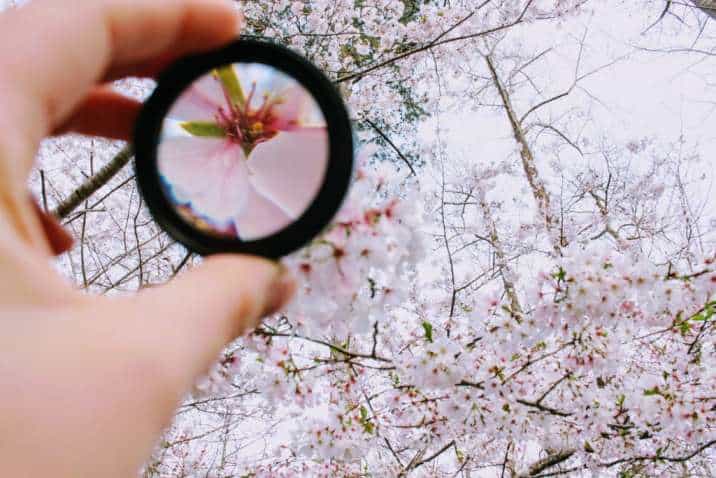
Joe Polish has this funny way of saying, and he says everybody has something to teach you, even if it’s just an example to be a warning to others. Something along those lines.
I digest that statement. That allows us to be open 24/7.
So I’m curious if we were to kind of follow you from birth, what were some of the most pivotal, profound, defining moments of your earlier years? I mean, you were taught yoga since birth; as you said, I’m curious what that would have been like to have experienced a childhood that way.
By the times of your tremendous success have been times of your most significant risk.
Experiencing childhood through a yogic perspective was two things. It was very embracing and endearing, and extremely frightening. The frightening part was when, as a young child, having not developed my full personality, being very impressionable, which is where all children are at. I would go out into the world, and the world is competitive, but I come, and I would come back home into a world that had zero competition. It was all about compatibility; it was all about how I can serve you; it was all about how I can help you. And then I go out into the world which was extremely competitive. Like teachers, for example, would send notes home to my parents, because I just thought school was the greatest thing because it was a room gathering all my friends, right? And that we were compelled to be together for an entire day, right? Every day, five days a week. So I would get my work done quickly, and then I would visit with my friends. So the teachers would send notes home, like, “We can’t get him to stop talking,” and my parents would send them back and say, “We can’t either.” So I grew up working very diligently to create safety in what appeared to be very unsafe circumstances, very competitive, combative circumstances.
Because of the true human nature, not the way we have gotten to in today’s world, but the true nature of humans, “hu” means “light,” and “man” means “minds.” So we are a being that has light in mind. The true nature of a human being is to be like what you and I are; we’re adding on to each other’s statements rather than trying to compete for a greater statement in some way. Life is not a debate. Life is let’s find someone else’s opinion, and let’s see how that fits and sits within our world, which is going back to earlier, you saying that what somebody else thinks of you is none of your business. That idea, if you take the way other people think, and this I had to learn the hard way, and direct answer to your question, my experience growing up in my very youngest years was that I had to learn it the hard way not to incorporate people’s competitive and combative natures. Bullying if you will, how I could include that in my picture, rather than excluding myself because it was too powerful or try to compete with them. And it was that I learned later in life, through my study. The dance that Lao Tzu talked extensively about in the Dance of the Absolute that learning to dance with that opposing force; going back a couple of statements in our conversation here, learning how to dance with the opposing forces will teach you how to use their energies, not in opposition to your purpose but as an energy that furthers your purpose. And so, that was the earliest part of my childhood.
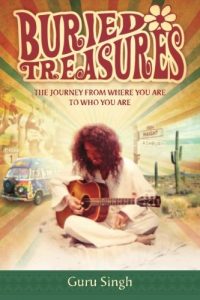
Then come later in my life, when I was, how old was I? I was at the age of 20. I died in a hospital of peritonitis, which was from a ruptured appendix. I had no heartbeat and breath for a minute and 45 seconds. And during that minute, 45 seconds, I traveled into space beyond space and experienced a significant structure outside of the structure that you and I are talking about being on the 1%. And I wrote about this in a book called Buried Treasures. And it was an opportunity for me to assemble what I have been working with earlier in life into what I was going to be working with later in life. At that pivotal point, kind of that reboot, if you will, at the age of 20, I took all of what you had asked about that had taken place in early life and learned how I might be able to employ it for the rest of my life. And that’s when I determined that my life was going to be a life of service and a life of teaching and a life of continuously seeking a higher view, a higher perspective of everything that was taking place. Those are the kind of two modules in answer to your question. There was the life of being raised by yogis and an artist and a musician, both of which I incorporated my teaching. Here’s a little bit of the art you can see right here because this is my virtual classroom. And there are two of my many guitars back there that you can see. And so I incorporated all of these components after this reboot, a moment of death to just go forward and be as free from that enslavement of the outer expectation as possible.
Wow.
And I’m sure by the times of your greatest success, have been times of your greatest risk.
Yes. And some of the most pivotal times in my life were the most painful for sure. So I went through a tough divorce 11 years ago, and at the time, I was depressed and had a really hard time with it. But the gift was three different people telling me; seemingly, it was like the universe talking to me telling me you got to go to this Tony Robbins event, Unleash the Power Within. That was happening locally, and I wouldn’t have gone otherwise. But three different people who didn’t know each other, within two weeks of each other telling me, “You need this, you need to go this Tony Robbins thing.” And I knew nothing about him, but I signed up, and I had no idea I was going to go on a firewalk that first day, that first night. I almost chickened out but I did it.
The most profound moments of growth are also the most painful.
Right. You just said a moment ago that sometimes the most profound moments of growth are also the most painful. I mean, there it is in actuality; I guess I would not call it a metaphor; you’re challenging yourself to walk on hot coals. And what you feel at the end of your experience is like, “Wow, I can do anything.”
Exactly. So it was at that moment, walking across the coals not getting burned and celebrating that success right afterward, that I realized that I could do anything. I could go and get that LASIK surgery that I had been thinking about doing but was terrified to do. I didn’t want any eye surgery or anything and getting a hair transplant; I got two months after that, which has completely transformed how I look. Like 10-15 years younger after that transformation that I did with those different things plus the diet changes and the exercise changes and all that. So yeah, I kind of got a reboot, like you did, but I didn’t have a near-death experience, thankfully, I guess. I mean, I can see from your perspective a little bit that what a gift it was, even though it must have been something to go through, to have died for a minute and 45 seconds. I’m guessing that you look back on that, seeing that as a gift now, is that correct?
The basis of most spiritual teachings is to unmap all of the inner relationships and illusions. By doing so, you begin to see things not as you believe they are, or as you think they are, but you can start to perceive things as they… Share on XYes. If we were to compare what you just described to what I just described, we’d conclude that the only difference was not in the intensity. The difference was the time that the intensity was spread out over. So you went through the death of a marriage, right? You went through the death of your fear of that LASIK; you went through the death of your hesitation by walking across the hot coals, you went through a death of one appearance to take on a younger, more vibrant appearance, you went through the death of some of the old eating habits and some of the old exercise habits. So in all of those deaths and rebirth, if you just put all those into a single moment, it would be very much like the experience that I had.
In other words, that time it is a dilution of the intensity of a particular moment. That’s why I think that most people, if they get in touch with the things that we’ve gotten in touch with, they will discover that, oh, that’s not that book, Buried Treasures is not just about Guru Singh. It’s actually about my life too. That I have those same things happening in my world, but they’re just in a different time sequence, the time may disintegrate; in other words, it’s not all happening in one moment. The moments may be stretched out over a longer period of time. But each and every one of us go through these kinds of events. And if we’re open to recognizing or recognizing them, we can put them into a perspective that allows us to gain the most from them to learn the greatest lesson from them. Like, I’m sure when you were in the midst of the divorce, it was the last thing that you wanted. And now you look back on it, you’re in a wonderful relationship, and you look back on that, and you go, “Oh, that was a schooling so that I could get ready for this one I’m in now.”
Right. To regret, for example, being in a marriage that wasn’t working for x number of years longer than it “should have been” is also something that doesn’t serve me because I realized that if I had gotten out of that marriage sooner, I would not be in this relationship, because we wouldn’t have met at that time at Date With Destiny in 2012.
Everybody has something to teach you, even if it’s just an example to be a warning to others.Guru Singh
Good for you.
Yeah, a platinum partner, a friend of ours, Adele, introduced us at the very end of the event.
That is absolutely perfect. I hope that your listeners and viewers can recognize that as you and I are discussing our lives, we’re not talking exclusively about our lives; we’re talking about how they can look at their lives and go, “Oh, wow, I’m similar to that which these two are talking about. There’s this time in my life, and there’s this other time in my life, etc.” Because when we can relate other people’s learning to our own lives, that’s when we gain an advantage from our relationship with other times and other people and other spaces and other circumstances.
Very true. So I’d love to go a little deeper into yoga specifically and understand what the different types of yoga are and how it’s more than just a physical workout. I mean, it seems like it has been almost dumbed down to that in a lot of Western physical fitness sort of culture, but it’s a very profound spiritual discipline as well. And there are different types of yoga, and Kundalini yoga is that particular type or discipline of yoga that you practice and teach. And I would love for our listeners and myself to understand more about these different types.
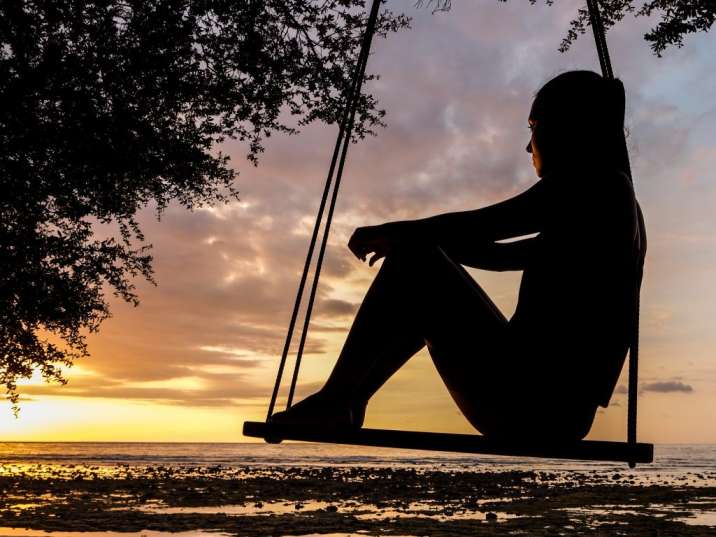
Excellent. Well, I have a teaching aid here. Here we have a depiction of a human body. In this particular depiction, we have this green area down here, this is the pelvis, these are the two legs, and this is drawn energetically rather than anatomic. I mean, it’s where the pieces are, but it’s more of a showing of what are the energies of these various parts. This circular pattern here is the belly, the abdomen, and then this squiggly green line across is the diaphragm, the largest muscle in the body, then we have the two lungs, and we have the heart. And this area of our body is energized because it doesn’t move about, we can move our arms, we can move our legs, but this particular area of our body, it’s not like you can shift your lungs, it’s not like you can shift your heart, but we can shift how they are working by the various movements that we use in our body.
All forms of yoga use what’s called “asana,” which means posture. All forms of yoga use “pranayama,” which means breathing exercises. And all forms of yoga use “mudra,” which is the position of your hands. And Kundalini yoga uses an extensive amount of mantra or sound. As you recall, when Tony would talk about the reticular formation, which is the medulla and the pons, in the primitive portion of the brain. What chanting does, what mantra does is mantra affects that medulla and the pons, that reticular formation, because that holds your instinctual behavior patterns. All of these body parts hold certain patterns of life. They hold our belief systems; they hold our circulatory, our capacity to circulate outside is similar to our capacity to circulate inside, and digestion. Digestion takes what we connect to, let’s say in the form of food, and it subtracts the waist from the nourishment allowing us to metabolize the nourishment. Metabolism is controlled through the thyroid and parathyroid glands in the neck. So all of these yogic asanas are specifically focused on these various parts of our body, using the arms and the legs to emphasize them.
All of the yogic posture, yogic breathing, yogic mantras, all of these things affect all of the parts in your physical body.
When you put your arm up at 60 degrees, it draws a line that passes directly through your heart center. If you put both arms up at 60 degrees, it crosses at the heart, right, these two energies are not just a metaphysical sense, but the nerve lines cross through the heart. So all of the yogic posture, all of the yogic breathing, all of the yogic mantras, all of these things affect all of these parts of your physical body. Then your physical body develops and secretes the hormones, peptides, proteins, and lipids that produce your blood chemistry. And your blood chemistry is then analyzed in the brain in the limbic portion of the brain, specifically the hypothalamus gland, to determine how do you feel. It happens instantaneously; the blood chemistry registers, and suddenly you’re angry, suddenly you’re happy, suddenly you fall in love. These things, if you slow down the time sequence, are the various glands and organs of your body registering through the blood into your brain.
Yoga helps you to balance those signals. So that if the signals are off, you can correct them. And if the signals are spot on, you can use them. And this is the purpose of yoga; this is also the purpose of meditation. Because in meditation, what you do is you allow yourself to take that, as they would say, that 300,000-foot view of all that’s going on in your life and your world. And you might use a mantra to clear the reticular or the instinctual reactions, the instinctual responses so that rather than having instinctual emotional responses, you can have intuitive, emotional responses. Because the emotions are powerful, it’s just how we use them that determines whether or not they’re useful or disruptive. So that’s kind of a thumbnail of what physical yoga does and what the meditation process does and what the singing and chanting process does.
The emotions are powerful. It’s just how we use them that determines whether or not they’re beneficial or disruptive.
So what’s the difference between Kundalini and then like hot yoga that you would go into a hot yoga studio to do?
I’ll answer the question by asking a question.
Okay.
What’s the difference between a Lexus and a Mercedes? A lot of similarities, right? They both have four tires, they both have a steering wheel, they both have a throttle and a brake, an engine, seats, they have some gauges that tell you if you’re going in the right way or not. It’s just the feel of the ride. So whether it’s Vinyasa, or Hatha, or Hot, or Yin, whatever it is, or Kundalini, you’re basically in a vehicle, that’s going to get you to balance the whole part of your life, that if you don’t balance it, it will ultimately end up in an imbalanced way just because you’ve been influenced by the way life is unfolding. Rather than being the influence on how life is unfolding. So we use yoga to balance all of our body, the circulatory, the respiratory, the digestive, the muscular system, the nervous system, the glandular organ system. And if we balance all of this, we become like a newborn where everything is not being influenced by the conditions around it. It’s being influenced by its main purpose, which is the main purpose of physicality is to be healthy. The main purpose of emotionality is to be joyful. The main purpose of mentality is to be knowledgeable. And the main purpose of spirituality is to be free. Doing yoga makes those main purposes easier to accomplish.
Gotcha.
The information is already within us, which is why we remember, recall, and recognize. We're merely just becoming aware of what's already there. Share on XSome people like Lexus, others like Mercedes. Some people like hot yoga, others like Kundalini yoga; it’s a matter of taste in my estimation.
Okay. Do you think that a trip up a mountain and going into a cave for a period of time is something that is going to be helpful for our listeners? Was that ever something that you did?
Yes. If they read my book, Buried Treasures, I spent some time with an indigenous village in the way back out of the way, what’s called an “uncontacted village,” a village of indigenous people that had no relationship with the outside world. And that was like going to a cave. I mean, I went into a cave with them, but that’s very helpful. It’s not always very able, people aren’t always able to do that, and so my suggestion is that if you have that opportunity, take it. But until you have that opportunity, take the opportunity that you have every day and go into the cave of time. Take a few moments, take several minutes to be just by yourself. Be by yourself in a space that is going to be uninterrupted by any kind of device, any kind of outside communication.
That’s a reboot as I used the term previously, that can be a small reboot that will help you through the rest of your day. You do it again the next day, and you get an even greater perspective. You do it again, the next day, you get a greater perspective. It’s what we call in Sanskrit, “Sadhana.” And what sadhana is just a daily practice. Every one of us has a daily practice where most of us have a daily practice of breakfast. Where does the word breakfast come from? It comes from breaking the fast, the fast of not eating throughout the night. If you were to have additional practice, you have a practice of breakfast; you have a practice of showering or bathing, you have a practice of eliminating your waste. You have all of these daily routines; if you want to get to a more maximized state, add a routine of some kind of yogic physical activity and meditative prayerful practice. They become extremely helpful in creating a balance in your life physically, emotionally, mentally, and spiritually.
If you want to get to a more maximized state, add a routine of some yogic physical activity and meditative prayerful practice. They become extremely helpful in creating a balance in your life physically, emotionally, mentally, and spiritually.Guru Singh
What kind of prayer rituals or practices do you incorporate into your daily life?
I do chanting, which clears the brain so that you can sit in silence.
For how long?
I usually chant for about, well, depending upon the day and the amount of time that I have in a day, I’ll chant from between 10 and 30 minutes. Some days I’ve chanted longer, but I’m talking about what’s normal for me. And then to put my body into a balanced state, not only for the activities of the day, but also just the activity of sitting in silence and not twitching and ditching, and whatever. I do a good 30 minutes of yoga. So if I chant and do yoga, then I can sit in an exploratory way in meditation. Meditation is like taking contemplation and slowing it down even more. If you measure it in the brain, you go into what’s called a theta state, which is the dream state in the brain. And when you enter that theta state, while you’re still conscious, this is what is also known as lucid dreaming. And many great brains, Einstein, Tesla, Thomas Edison, Leonardo da Vinci, many great brain powers, let me talk about some women. Mother Teresa, Madame Curie, many intelligent and great brain powers, used dream sequencing, or lucid dreaming, or, as I’m calling it, “deep theta brain meditation” to view their world from that 300,000-foot level, so that their world isn’t just a jumble of the parts, but it’s a picture of the whole. So it’s a holistic view of life. So I do yoga to get my body in shape, I do chanting to get my psycho-emotional system in shape, and then I sit in and come into this deep, contemplative, meditation theta state. That’s my daily routine.
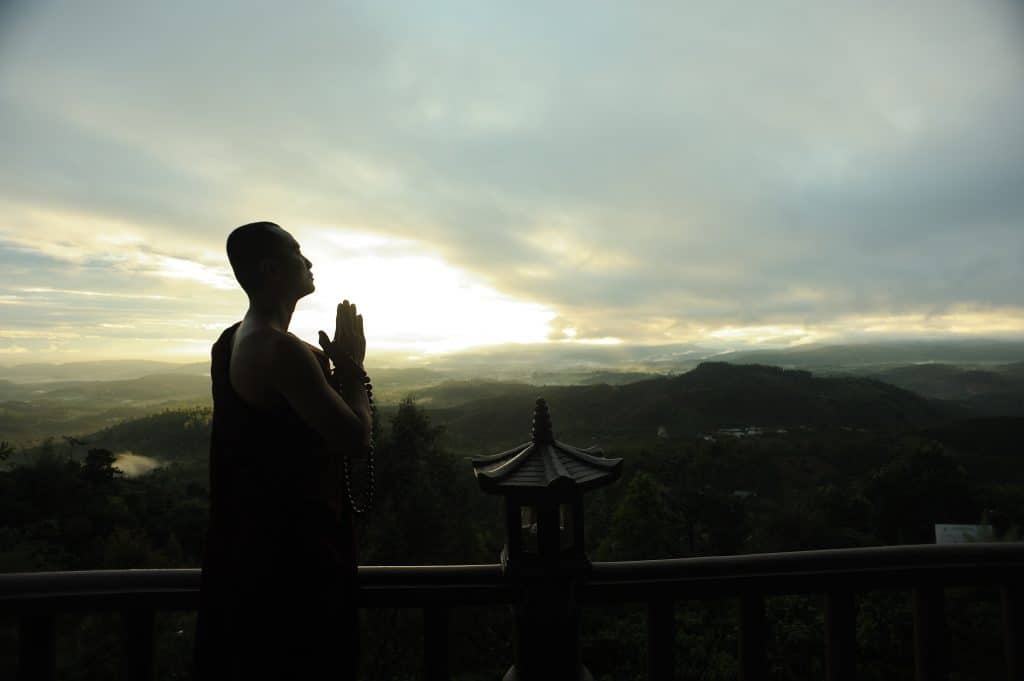
When you’re talking about chanting, that reminds me of a particular time we were chanting. My wife and I, she wasn’t my wife yet then, but we were at the Oneness temple, outside of Chennai. We were chanting for me; it was like 49 minutes or 53 minutes. I can’t remember, it’s one or the other. Does 53 have a particular significance or 49?
Well, they both do in the Oneness tradition. Just like the difference between cars, in the Kundalini tradition, the number of minutes is based on the way the ancient yogis would time themselves because there were no clocks in those days. And they would time themselves by numbers of breaths, and they would also time themselves by numbers of heartbeats. They would average out the heartbeat and numbers of heartbeats. And so the Kundalini numbers are 11, 31, 62 as far as the number of minutes. In the Oneness tradition, I remember they were both those numbers 49 and 53.
Be in a “relation-ship,” not a “relation-canoe,” because both of you can stand up in a relationship, but in a canoe, if anyone stands up, it capsizes.
Okay. Well, it was one or the other, and we just kept saying over and over again, “I’m existence consciousness bliss. I’m existence consciousness bliss; I am existence consciousness bliss.” And you would think that it would get boring doing this for 53 minutes, nonstop. But it ended up being incredibly profound. In fact, my wife had an out of body experience. It was amazing. Like she ended up in exceeding, from the point of view of a stray dog out on the campus. What that dog was thinking and experiencing, then she floated up to the top of the temple, and there were monkeys up there. And yes, there were monkeys up on that temple. She understood that this one monkey thought that he was the king of the world.
Isn’t that great? How many monkeys and I’m not talking about actual monkeys, but human monkeys think they’re the king of the world.
Yeah, pretty cool.
So what you’re talking about in Sanskrit is called “nam,” or words, write names, and “Simran,” which means repetition. And when you take a short phrase or a longer phrase, and you continuously repeat it, what it does to the brain, which is every two dimensional; right, wrong, good, bad, yes, no, it’s measuring; left, right up, down. The brain in our head is constantly measuring. And what we want to do is we want to take it out of that comparative measuring attitude and get it into the exploring curious, regulatory kind of attitude. And one of the ways of doing that is by giving it a task, which it goes, “This is gonna be so boring.” and you don’t release it from that task, you keep on saying that over in existence, existence, consciousness, bliss, existence, consciousness, bliss, over and over and over. And pretty soon, the brain goes, “Okay, you guys are too much. I’m outta here.” And that’s exactly what you want it to do because the moment the two-dimensional analytical brain in your head goes, “I’m out of here.” Suddenly, the neurology in your heart center, and the neurology in your gut center, which is the three brains of your system, suddenly open up.
When we can relate other people’s learning to our own lives, that’s when we gain an advantage from our relationship with other times, and other people, and other spaces, and other circumstances.
Now, instead of seeing things in a comparative–back to my original statement–instead of seeing things in a comparative and combative way, you see things in a connective, nourishing way, in a circulating breathing kind of life-giving kind of way. You still get a balance of the analysis, but the analysis of your head brain is not dominating. When you get this balanced view, that is what yoga is. Yoga means union or to unite. When you’re able to experience, like your wife, that was so beautiful, experiencing it through the eyes of others. Imagine being able to see what another person is seeing. Let’s just say that you’re in communication with someone who you work with, someone that you have to live around or be around, and there’s always something that is in conflict. Doing what your wife had an experience of doing, and suddenly seeing it through the world through the eyes of another, my god, now you have the ability to not only see it as they see it but to also allow them to see you as you are. You can create that relationship; it’s called coherence. When there is that coherence, suddenly now there’s a true relationship as opposed to what I always use the expression, you want to be in a “relation-ship,” not a “relation-canoe,” because in a relationship, both of you can stand up, but in a canoe, if anyone stands up, it capsizes.
Right. This is good stuff. And we’re coming close to time here. I want to kind of switch to a bit of a lightning round for the last few minutes. Let’s start with Yogananda. So Yogananda had this amazing book, Autobiography of a Yogi, which I understand, it was the only book that Steve Jobs would hand out to all his visitors, like personal visitors. And so it was a profound book for him, a profound book for many people. I have not read it; I’ve been to the Self Realization Center in Pacific Palisades. It’s beautiful.
The times of your greatest successes have been times of your greatest risk. Share on XYes. The Lake Shrine?
Yes, Lake Shrine Temple. They’re cool. And I’ve seen the Awake documentary, which was fabulous about Yogananda. It was on Netflix, I think, might still be on Netflix.
Yeah. Some close friends of mine created that.
All right. So what would you want to share, like as a quick little tidbit for our listeners or viewers about Yogananda that would pique their interest and get them wanting to dig deeper?
The main purpose of physicality is to be healthy. The main purpose of emotionality is to be joyful. The main purpose of mentality is to be knowledgeable. And the main purpose of spirituality is to be free. Doing yoga makes those main purposes easier to accomplish.Guru Singh
Yogananda had tremendous innocence. In that innocence, he is able to relate the way a person feels almost childlike. When you read his books, you see the world as a child sees it with innocence and curiosity. And that’s what I found to be most compelling. His teacher Sri Yukteswar has been described by both my ancestors because they were students of his, and also, as described by Yogananda, was a very pragmatic type of Yogi, which I think is very appealing in the world today. In that pragmatism, what in Sanskrit is called […], is the ability to be highly enlightened, highly awake, and very practical, to own property, to have a business, to have a family, does not have to go into seclusion to maintain your awareness. That is the combination of Sri Yukteswar, and Paramahansa is what I find most compelling about that particular lineage. Then you have the Kundalini lineage, which goes back through what is known as the Nahum Sikhs and the Udasi Yogis. That lineage, the Sri Yukteswar Yogananda lineage, came out of Northeast India, and the lineage that I also follow because I follow both came out of Northwestern India, which is home to the Khyber Pass, and all of the invasions that came into India.
The Russians invaded, the Greeks invaded, the British invaded, all of the invasions that came in. So the yoga that was coming out of the northeastern portion of India was not only the sage of what we were just describing, and not only the practicality of Grihastha Ashram, the sage of Yogananda, the practicality of Grihastha Ashram, of Sri Yukteswar but also the warrior class. Think about when you were with Tony; Tony had a brilliant business mind, he had a tremendous intellectual sage consciousness, and he was a warrior. Walking across those hot coals, those burning coals requires the attitude of a warrior. If you link those parts inside of you, the various lineages inside of you, the lineages of the warrior class, which is Kundalini Yoga, the lineages of the business class which is not only Kundalini, it’s Hatha, and it’s all of this with that practicality, the Grihastha Ashram. Then the lineage of the very saintly sage, the euphoric sensations, which is also contained within all of these paths. That’s a balanced approach to life.
When we can relate other people's learnings to our own lives, that's when we gain an advantage from our relationship with different timelines, people, spaces, even circumstances. Share on XYes. Wow. Okay. So how do we get our listeners to learn more and to kind of deep dive into Kundalini Yoga and learn from you? Like you must have a set of courses and programs and so forth, so where should we send them?
Well, we have a 16-hour course, the next one is starting in less than a month. There’s another one starting in March, and then there’ll be another one starting next August. That’s a 16-week, 200 hours deep dive into Kundalini Yoga. When you graduate from that course, you’re certified through an international certification system called Yoga Alliance. And that’s through kundaliniuniversity.com; you can also access all of this through gurusingh.com. Also, for the less intense, we have classes on the platform, Kundalini University Foundation, also accessed through those two same websites. You can find weekly schedules of classes on meditation on yoga; we’re gonna end up having an app in the near future that sort of associates all of this together. Where can you just go to a one-stop-shop, and do I want to meditate? Do I want to do a yoga class? Do I want to take a 200-hour course and do it all right there out of your pocket computer or smartphone? So we are up and running in the digital age and available to everyone globally.
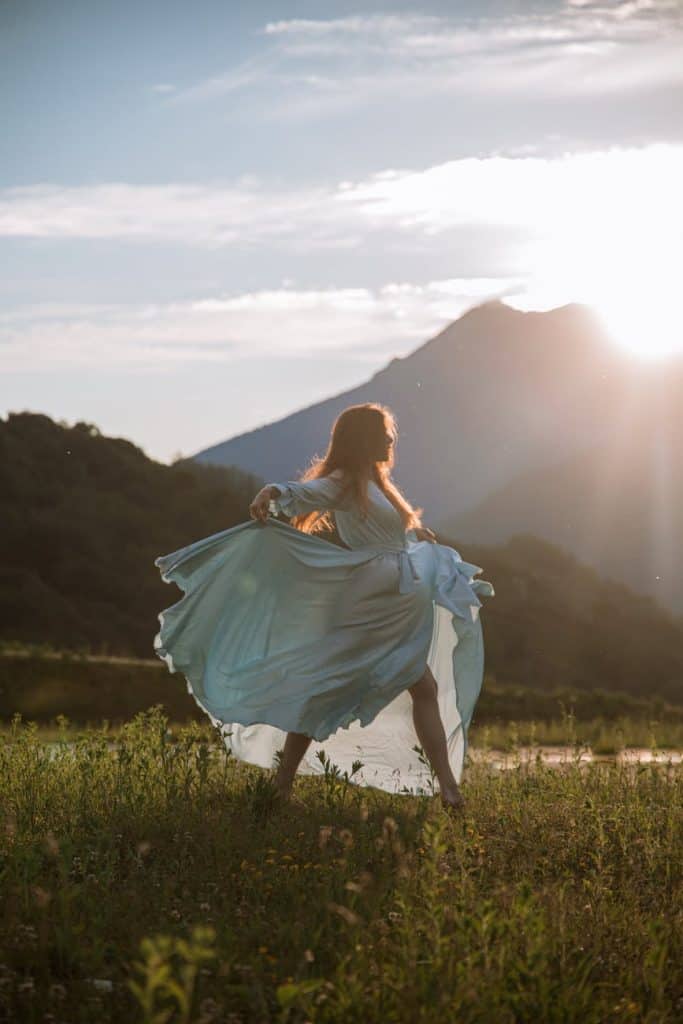
Awesome. Well, this has been fabulous. Guru Singh, thank you so much. I appreciated you from the moment that I’ve met you; I’m really happy to have had the opportunity to share you with my tribe. And I hope that my listeners will now take some further action and go deeper with you. Thank you again.
Thank you, and congratulations, just take a moment. Congratulations on finding the love of your life through the risks that you took, that entered you into the things that shall put you both together. Whatever romance that is, God bless you.
Yeah, thank you. It is such an incredible blessing. And it wasn’t until that moment that I surrendered to the universe, to the creator, that she showed up. It was when I prayed for her 12 hours before we met. It was the last minute I was working on my poster board for Date With Destiny doing my relationship vision, writing that up who I would be, and what the relationship would be like and everything, and I prayed for her, prayed to the Creator, to my Divine for her to show up while I was writing up that relationship vision on the poster board.
Wow, what a great success story. Beautiful.
Thank you, Guru Singh.
Thank you. And God bless you, all of you who listened in and viewed this incredible man and all that he’s dedicated his life for.

